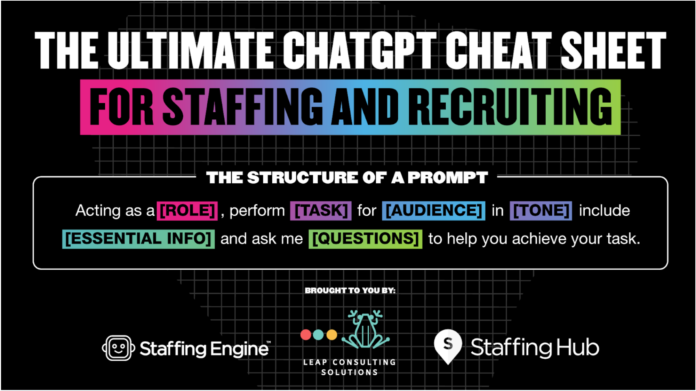
By Andrew Kimmell, Co-Founder of Staffing Engine
You’re seeing it everywhere – in articles on Forbes, in posts on social media, in jokes on your favorite TV shows: AI is the talk of the nation. And with good reason. Not since the dawn of the internet has a new technology had the power to transform the way we connect, the way we do business, and the way we live.
ChatGPT is a huge part of how innovators are understanding the vast potential of AI. Though ChatGPT is dead simple – tell the bot to do what you need it to do – in practice, getting the system to return what you need takes training. Think of ChatGPT as another intelligent digital worker. Just like your human employees, you need to teach ChatGPT what you want and how you want it.
Here’s our ultimate cheat sheet on how to craft the best prompts to tap into the power of ChatGPT for your staffing and recruiting agency to save time and streamline repetitive processes.
Let’s break down each element of the structure of a prompt:
Acting as a [ROLE], perform [TASK] for [AUDIENCE] in [TONE]. Be sure to include [ESSENTIAL INFO]. Ask me [QUESTIONS] to help you achieve your task.
1. [ROLE] Start by telling ChatGPT the role they are playing
ChatGPT is able to include how a user’s needs vary depending on their role on your team. A recruiter writing a series of job tweets has a different set of objectives than a sales director tapping AI to write an email sequence, and ChatGPT has a large langage model able to reflect that.
So, start by telling ChatGPT the role they will be playing. Often, this will be a user’s own role in your organization.
Here’s a list to choose from:
- Recruiter
- Marketer
- Sourcer
- Sales Rep
- Account Manager
- Payroll Coordinator
- Compliance Officer
- Marketing Associate
- Branch Manager
- Client Services Lead
- Account Director
- Recruiting Director
- Sales Director
- Compliance Director
- Marketing Director
2. [TASK] Tell ChatGPT the specific task they need to achieve
Next, you want to clarify what task you want ChatGPT to perform. As an AI language model, ChatGPT thrives on specificity. Like a human employee, the more detail and clarity you can provide when describing the task you’d like the bot to take on, the better your results.
Here are some examples of staffing and recruiting tasks ChatGPT can help your team with.
- Social media job posts
- Email sequence to passive candidates
- Redeployment outreach
- Interview invitations
- Job offer letters
- Rejection letters
- Compliance checklists
- Client services contracts
- Sales copy
- Web copy
- Ad copy
- Video scripts
- Blog posts
- Headlines
- SEO Keywords
3. [AUDIENCE] Specify the intended recipient(s) of your project
As with role, ChatGPT comes to you with an impressive knowledge of the different kinds of people you may be reaching out to. When specifying who your intended audience is, you can be broad (passive executive candidates) or specific (Tanya Jones, CEO of Brandize Industries).
Here’s a list of common targets in staffing and recruiting:
- Passive candidates in [specific industry], i.e. Passive candidates in healthcare administration
- Passive candidates who are currently [job title], i.e. Passive candidates who are currently forklift operators
- Candidates actively searching for a new role as [job title], i.e. Candidates actively searching for a new role as a mechanical engineer
- New hires
- Candidates interested in redeployment
- Dormant candidates who haven’t heard from our firm in awhile
- Executives at a [business size] [specific industry] company, i.e. Executives at a mid-sized insurance company
- Prospects who meet the criteria of your buyer persona, i.e. HR directors at tech firms with 30+ employees in Baltimore
- Web browsers who are interested in finding a new recruiter
- Web browsers who are looking for a new job
- Twitter users who hate their jobs
- Candidates who will not be offered the position they applied for
- Candidates who will move on to the next round of interviews
4. [TONE] Specify the tone you’d like ChatGPT to use
With practice, observation, and trial and error, your team likely understands a bit about what tone of voice works in professional writing. They know that job tweets will have a friendly, fun, engaging tone while a series of emails will be more conversational.
Because it doesn’t have real-world experience, ChatGPT needs to be told specifically what tone you would like it to use.
You may not think tone is important, but check out the difference it makes. We asked ChatGPT to write an email as a recruiter to a prospective candidate.
Here, we specified the bot write in a serious, professional tone:
Subject: Exploring Job Opportunities – Request for Phone Discussion
Dear [Candidate’s Name],
I came across your profile and was impressed by your experience and qualifications. As a recruiter with [Staffing Firm], I wanted to reach out and see if you would be interested in scheduling a brief phone call to discuss current job opportunities that may align with your skill set. Please let me know your availability, and I will be happy to arrange a convenient time for us to connect.
Thank you for your time and consideration. I look forward to the possibility of speaking with you soon.
Best regards,
[Your Name]
[Your Title]
[Staffing Firm Name]
Here, we asked ChatGPT to write the same email in a chatty, witty tone:
Subject: 🌟 Let’s Chat! Exciting Job Opportunities Await! 🌟
Hey there, [Candidate’s Name]!
I stumbled upon your amazing profile and couldn’t resist reaching out. Your skills and experience are seriously impressive! I thought it’d be awesome to schedule a quick phone call and explore some fantastic job opportunities that are right up your alley. What do you say? Let’s make some career magic happen! Just let me know your availability, and we’ll set up a time to chat.
Looking forward to connecting with you and unleashing your career potential!
Cheers,
[Your Name]
[Your Title]
[Staffing Firm Name]
Each of these emails has an audience that it might be effective for – and each email has an audience for whom it would be inappropriate. For example, you likely wouldn’t send an executive prospect an email with stars in the subject line, but you might want to go that route when sourcing substitute teachers.
Here is a bank of tone descriptors you can use to craft the perfect text with ChatGPT:
- Professional
- Serious
- Informational
- Persuasive
- Convincing
- Articulate
- Friendly
- Engaging
- Conversational
- Witty
- Creative
- Inventive
- Humorous
- Empathetic
- Expressive
- Candid
- Empowering
5. [ESSENTIAL INFO] Provide clear, specific instructions based on your needs and requirements
To get the most out of ChatGPT, it’s great to give it all the essential info it needs from the top. Here are some things you might want to clarify in your prompt:
- The action you’d like your audience to take. For example, you may want candidates to book an informational interview or prospective clients to email about your services.
- The essentials of any job-related texts. For example, you may want to include location, salary, shifts offered, and start date.
- The goal you’d like to achieve. For example, you may want to drive more viewers to your website or more conversations to your chatbot.
6. [QUESTIONS] Invite ChatGPT to ask you clarifying questions
ChatGPT can also help you craft the best prompt to get what you need. How? By asking you questions to help you dig into exactly what you need. It’s often helpful to tell ChatGPT directly to ask you questions in order to yield the best results.
Put it all together [and tap these ChatGPT Prompt Templates]
So, putting it all together, here’s a basic template for a ChatGPT prompt:
Acting as a [ROLE], perform [TASK] for [AUDIENCE] in [TONE]. Be sure to include [ESSENTIAL INFO]. Ask me [QUESTIONS] to help you achieve your task.
Here are some examples of how all the different aspects come together into one prompt:
- Acting as a marketer, create 10 social media job posts for open travel nurse positions in Colorado, Idaho, and Montana. Make the posts in an engaging tone. Be sure to include that salary info is available upon request. Also include that both day and night shifts are available. Ask me 3 clarifying questions before you begin in order to succeed at this task.
- Acting as an executive recruiter, write three cold emails, reaching out to passive executive candidates about a CFO position. Write the posts in a professional, respectful tone. Be sure to include that the available position is remote and that the company is looking for someone with experience leading diverse teams. Ask me 3 clarifying questions before you begin in order to succeed at this task.
- Acting as a sales representative in the staffing and recruiting industry, please create a contract for services for a new client. Write the contract in a professional, legal tone. Include a clause stating that either party may terminate the agreement with 30 days’ written notice and that the monthly rate is $12,500 for an ongoing staffing consultancy. Ask me 5 clarifying questions before you begin in order to succeed at this task.
- Acting as a marketing director, create a pitch deck for 21st Century Staffing based on the information in our website www.21stcstaffing.com. Write the deck in a creative, engaging tone. Highlight our services, how we stand out from the competition, and why the client should choose 21st Century Staffing. Ask me 5 clarifying questions before you begin.
Give ChatGPT feedback when it doesn’t hit the mark
Like a good human employee, ChatGPT is responsive to feedback. Not only does feedback help ChatGPT perform your task better, it helps make the language model as a whole more effective.
Some things to think about when collaborating with ChatGPT and offering ChatGPT feedback:
- ChatGPT can create misleading or biased texts. A human reader should always review any text that ChatGPT creates for candidates or clients to ensure that it is consistent with reality and with your agency’s values.
- Similarly, ChatGPT will make up facts, links, and very specific information that is not true. Be sure to fact-check any information generated by ChatGPT.
- With ChatGPT, the more specific you are, the better results you will get. If you just say, “Wrong!” the bot won’t know how it can change results to meet your needs.
- Point out errors in clear, precise language.
- The tone of this proposal is not engaging enough. Please try again and add more humor and creativity.
- This does not meet the specified criteria for an email template. Here is an example of an email template [example]. Please ask any clarifying questions you need to proceed and try again.
- Since ChatGPT learns within a chat, you can refer back to previous information you’ve given.
- The image links I requested are not relevant to publishing. Please provide new links. [Note that ChatGPT is not adept at providing relevant links and tends to make up any links you request.]
- Though developers are working on updating the bot, ChatGPT struggles to incorporate information that went online after 2021.
-
With thoughtful use of ChatGPT and with human oversight in place, the tool can help your team be more productive, delegate busy work, and boost revenue. Due to the widespread adoption of this cutting-edge technology, any company that does not use AI will fall behind the competition.
 Andrew Kimmell is a creative, entrepreneur, and 4x founder. He’s currently the Co-Founder of Staffing Engine, a Recruiting Acceleration AI for staffing firms. Prior to this, he Co-Founded TextUs, a pioneering business text messaging software in the staffing industry, and Rage Digital, a firm creating innovative mobile apps. His work has been featured in publications like Computer Arts, Print Magazine, and Entrepreneur.
Andrew Kimmell is a creative, entrepreneur, and 4x founder. He’s currently the Co-Founder of Staffing Engine, a Recruiting Acceleration AI for staffing firms. Prior to this, he Co-Founded TextUs, a pioneering business text messaging software in the staffing industry, and Rage Digital, a firm creating innovative mobile apps. His work has been featured in publications like Computer Arts, Print Magazine, and Entrepreneur.





